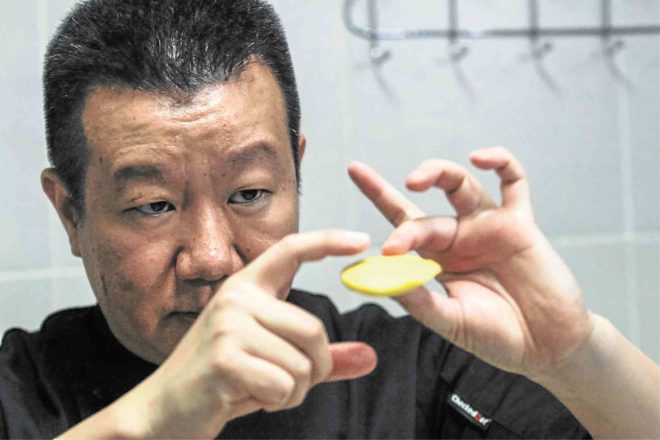
I winced as chef Jereme Leung demonstrated his knife skills in rapid-fire movement. There was a rhythm to his motions, the Chinese cleaver pounding on the chopping board like the steady beat of a drum.
But there was also danger. He was slicing a piece of char siu pork into thin strips without looking at what he was doing. His fingers seemed perilously close to being cut by the knife, yet he kept on talking to the class, as if unaware of any potential harm.
Fortunately, no such harm befell him, and in hindsight I shouldn’t have worried. After all, this was Jereme Leung, the renowned chef-owner of China Blue restaurant in Conrad Hotel Manila, and other restaurants all over the globe. He has been working in the kitchen since he was 13 years old, rising from the ranks to become one of the most prominent Chinese chefs worldwide, and a true pioneer in modern Chinese cooking.
He has won a number of awards—the Five Star Diamond Award from the American Academy of Hospitality Science, and the XO Hennessy Culinary Award, among others—and now runs his own company, the Jereme Leung Creative Concepts, which offers food and beverage consultancy services.
Hence, chopping a piece of meat while giving a lecture was, for him, probably just another easy task at the office.
Dumplings
That day, he taught us the intricacies of making two kinds of dumplings: a savory dumpling with char siu pork filling, and a sweet one, filled with purple yam. To the class, it seemed like a complex task, but for him, a no-brainer.
Working deftly, he mixed glutinous rice flour, wheat starch, fine sugar, pumpkin, boiling water and vegetable shortening into a smooth dough, which turned into a shiny golden color, with flecks of pumpkin which he said will make the dough taste even more delicious. Afterward he made us feel the dough, which was sleek, well-polished, with no rough surfaces.
Filling the dough and sculpting them into pumpkin and carrot shapes was another thing. Leung rolled pieces of dough into smooth balls, then flattened them to form a kind of bowl to hold the filling. He then used a stick to mark indentations on each slice of rounded dough, then stuck a stick of clove on top to serve as a stem.
And, like magic, the dumplings turned into pumpkins. Then Leung wrapped char siu pieces into elongated shapes and stuck some leaves on top. Presto: instant carrots.
I managed to approximate the procedure and made dumplings that remotely resembled the ones he made (with a lot of help from executive Chinese chef Khor Eng Yew). Then we fried the dumplings in carefully tempered oil (60°) for three to five minutes. The dumplings are done when they start to float in the oil, Leung said.
The best part, of course, was the tasting. The dumplings were a seamless blend of yin and yang: magically crunchy, yet meltingly smooth. The char siu filling in the carrot dumpling was rich and tasty, while the purple yam was like the best ube jam I’ve ever tasted.
Summer offering
Yet all that was just a prelude. With obvious enthusiasm, Leung served us a five-course set menu, which he has specifically created as a summer offering in China Blue. The menu was of special significance to him, said Leung, because he created it based on the indigenous ingredients he has discovered in the Philippines.
“I want to explore these ingredients and see how I can use them in my restaurants in other parts of the world,” he told us.
True enough, our pre-starter was braised beef with native eggplants encased in popiah wrapper. The starter of barbecued chicken, on the other hand, was flavored with tamarind sauce, while the wok-fried spareribs were laced with Batangas coffee sauce and topped with native pili nuts.
As good as they were, Leung really outdid himself with the soup. He was so proud of it, in fact, that he insisted on pouring it himself into each of our bowls. Kept piping hot by a flickering flame underneath the bowl, the consommé made with local kamias had a fullness of flavor that had just a wisp of the kamias’ sourness. In the soup were a large disk of poached scallop and fish lips, a gelatinous slab that reminded me and my seat mates of sinfully rich beef tendon.
Equally impressive was the main course: deep-fried fresh lapu-lapu fillet with mango calamansi sauce, a finely nuanced interplay of textures (crisp, flaky fish) and flavors, the sweetness of the mango cubes alternating with the tangy calamansi juice and the slightly spicy flecks of red pepper.
As we feasted on it, we could hear the crackle of something frying in one corner of the room. The sound was meant to be heard, said Leung, to heighten the anticipation of what was to come.
And what came was an enormous, fat prawn with an upturned tail, studded with a black rice coating. With a crunchy texture, the coating reminded us of the popped rice we used to eat as kids, which added a childish nostalgia to the appeal of this dish.
Refreshing dessert
For dessert, we had a refreshing chartreuse-colored sorbet made with malunggay leaves and cucumbers, surrounded by cubes of strawberries, melon and honeydew. Again, Leung insisted on spooning the topping of chia seeds personally on each of our sorbets.
It was a virtuoso performance by a master chef, one who had never wavered from his love of the culinary arts, his fame notwithstanding. In hindsight, I think we should have given him a big, resounding applause.
The tasting menu is P4,000 net per person, for lunch and dinner until April 30 in China Blue, Conrad Hotel Manila.
Call 6833915 for reservations or e-mail conradmanila@conradhotels.com